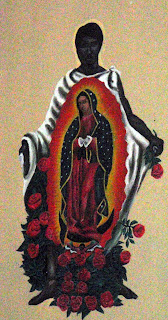 El hermanito de Lupita
El hermanito de Lupita Ana Guadalupe y Paloma
Ana Guadalupe y Paloma Marisa
MarisaWe got invited to a party by one of the prepa students. The prepa students are ages 16 up to 21. They do not have any professors that come to Tamaula so they take courses through the Prep@net program. Prepanet has been set up in communities in order for the youth to have an education without having to leave their communities. Some might not have money to send their children to Irapuato and this enables them to get an education taking courses in math, chemistry and other subjects while staying in their communities. Below you can see the inauguration of the new Prepa building. They had a library with books donated for them and computers that are connected to internet. It is a little weird to think that a town like Tamaula can have access to internet but has yet to have running water! Anyways getting back to the point, we partied with the prepa students and we learned how to dance to Norteño and Cumbia music! Picture this, we partied outside below the moonlight, the stars our feet in the mud, we could hear donkeys, goats, chickens and the turkey while we admired the unique scenery of the nightlights of the surrounding cities. It was wonderful. I really felt in Mexico! We danced a lot and we even introduced them to some “American” music and dance moves including the cue tip move inspired by the Hitch movie and the shopping cart! It was a lot of fun! I danced with one boy whose name is Juan Manuel, he is 16. He told me about his family situation. He lives in Irapuato with his older sister and his younger brother. His father left to the U.S. He told me that the last time he spoke to his father they had a fight. The father wanted Juan Manuel to come to the U.S to work and he did and still does not want to. He told me that if he were to go “al otro lado” it would only be on a vacation visa. He has no intent to stay in the U.S to work. He also told me that his father started a new family “al Norte” and he must have 4 step brothers and sisters. He does not go to school and told me that he prefers life in Tamaula to life in Irapuato. Life in Irapuato brings him to the “calle” and too many drugs and marijuana are in circulation. He told me that he prefers staying with his grandfather Don Pedro in Tamaula than staying at his mother’s which is to escape any social pressures.
Life in Tamaula is an escape, a refuge.
He told me that there are “chollos” in the street and I asked him what he meant by that. He described them as shaved headed and tattooed guys. We then moved on to discussing politics.
Juan Manuel dreams of traveling and now he wants to come to France! He told me that he wanted to see of his own eyes what life is like in the United States. The echoes he gets is that everyone is equal in the U.S. and this appeals and adds to the pulling and pushing effect of migration, and I can testify that little towns like Tamaula are greatly affected by migration.




